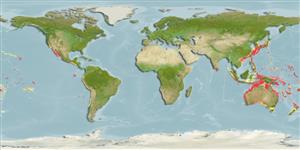Environment: milieu / climate zone / depth range / distribution range
Ecologia
marinhas bentopelágico; intervalo de profundidade 50 - 200 m (Ref. 11230). Subtropical
Southeastern Indian Ocean, western Pacific, antitropical.
Tamanho / Peso / Idade
Maturity: Lm ? range ? - ? cm
Max length : 35.0 cm TL macho/indeterminado; (Ref. 9137); 25.0 cm TL (female)
Espinhos dorsais (total) : 10; Raios dorsais (total) : 19 - 21; Espinhos anais: 3; Raios anais : 7 - 8; Vértebras: 26. Orange-red with black spots on the base of the dorsal fin (Ref. 43805). Congruent rays of the dorsal fin and a caudal fin rounded at the end, without a deep median notch, with only slight notches above and below in males, and with a very weak median notch in females (Ref. 43805).
Occurs inshore near reefs (Ref. 7300), on sand or rock bottom (Ref. 11230). Benthic and benthopelagic on hard substrates (Ref. 58302). Consumed as food (Ref. 559).
Ciclo de vida ou comportamento de acasalamento
Maturities | Reprodução | Spawnings | Egg(s) | Fecundities | Larvas
Kharin, V.Y. and V.A. Dudarev, 1983. A new species of the genus Caprodon Temminck et Schlegel, 1843 (Serranidae) and some remarks on the composition of the genus. J. Ichthyol. 23(1):20-25. (Ref. 43805)
Status na Lista Vermelha da UICN (Ref. 130435)
Ameaça para os humanos
Harmless
Uso pelos humanos
Pescarias: espécies comerciais
Ferramentas
Relatórios especiais
Baixar XML
Fontes da internet
Estimates based on models
Preferred temperature (Ref.
123201): 14.5 - 27.6, mean 23.3 °C (based on 380 cells).
Índice de diversidade filogenética (Ref.
82804): PD
50 = 0.6250 [Uniqueness, from 0.5 = low to 2.0 = high].
Nível Trófico (Ref.
69278): 3.4 ±0.45 se; based on food items.
Resiliência (Ref.
120179): médio(a), tempo mínimo de duplicação da população 1,4 - 4,4 anos (Preliminary K or Fecundity.).
Fishing Vulnerability (Ref.
59153): Low vulnerability (25 of 100).
